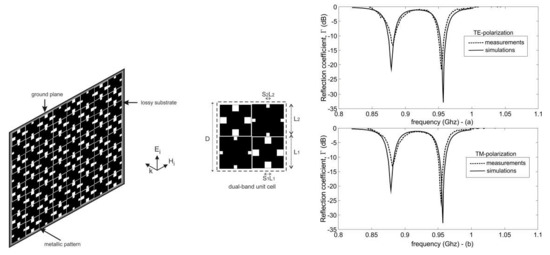A Dual-Band Compact Metamaterial Absorber with Fractal Geometry
Abstract
:1. Introduction
2. Dual-Frequency Fractal Unit Cell
3. Experimental Validation
4. Conclusions
Author Contributions
Funding
Conflicts of Interest
References
- Munk, B.A. Frequency Selective Surfaces: Theory and Design; Wiley Interscience: New York, NY, USA, 2000. [Google Scholar]
- Landy, N.I.; Sajuyigbe, S.; Mock, J.J.; Smith, D.R.; Padilla, W.J. Perfect metamaterial absorber. Phys. Rev. Lett. 2008, 100, 207402. [Google Scholar] [CrossRef] [PubMed]
- Watts, C.M.; Liu, X.; Padilla, W.J. Metamaterial electromagnetic wave absorbers. Adv. Mater. 2012, 24, 98–120. [Google Scholar] [CrossRef] [PubMed]
- Okano, Y.; Ogino, S.; Ishikawa, K. Development of optically transparent ultrathin microwave absorber for ultrahigh-frequency RF identification system. IEEE Trans. Microw. Theory Tech. 2012, 60, 2456–2464. [Google Scholar] [CrossRef]
- Costa, F.; Genovesi, S.; Monorchio, A.; Manara, G. Low-cost metamaterial absorbers for sub-GHz wireless systems. IEEE Antennas Wirel. Propag. Lett. 2014, 13, 27–30. [Google Scholar] [CrossRef]
- Costa, F.; Genovesi, S.; Monorchio, A.; Manara, G. Perfect metamaterial absorbers in the ultra-high frequency range. In Proceedings of the International Symposium on Electromagnetic Theory, Hiroshima, Japan, 20–24 May 2013. [Google Scholar]
- Zuo, W.; Yang, Y.; He, X.; Zhan, D.; Zhang, Q. A miniaturized metamaterial absorber for ultrahigh-frequency RFID system. IEEE Antennas Wirel. Propag. Lett. 2017, 16, 329–332. [Google Scholar] [CrossRef]
- Venneri, F.; Costanzo, S.; Di Massa, G. Fractal-shaped metamaterial absorbers for multireflections mitigation in the UHF band. IEEE Antennas Wirel. Propag. Lett. 2018, 17, 255–258. [Google Scholar] [CrossRef]
- Venneri, F.; Costanzo, S.; Di Massa, G. Multi-band designs of fractal microwave absorbers. In Advances in Intelligent Systems and Computing, Proceedings of the WorldCIST’18, Naples, Italy, 27–29 March 2018; Springer: Cham, Switzerland, 2018; Volume 746. [Google Scholar]
- Singh, D.; Srivastava, V.M. Dual resonance shorted stub circular rings metamaterial absorber. Int. J. Electron. Commun. (AEÜ) 2018, 83, 58–66. [Google Scholar] [CrossRef]
- Li, M.H.; Yang, H.L.; Hou, X.W. Perfect metamaterial absorber with dual bands. PIER 2010, 108, 37–49. [Google Scholar] [CrossRef]
- Jamilan, S.; Azarmanesh, M.N.; Zarifi, D. Design and characterization of a dual-band metamaterial absorber based on destructive interferences. PIER C 2014, 47, 95–101. [Google Scholar] [CrossRef]
- Dincer, F.; Karaaslan, M.; Unal, E.; Delihacioglu, K.; Sabah, C. Design of polarization and incident angle insensitive dual-band metamaterial absorber based on isotropic resonator. PIER 2014, 144, 123–132. [Google Scholar] [CrossRef]
- Park, J.W.; Tuong, P.V.; Rhee, J.Y.; Kim, K.W.; Jang, W.H.; Choi, E.H.; Chen, L.Y.; Lee, Y.P. Multi-band metamaterial absorber based on the arrangement of donut-type resonators. Opt. Express 2013, 21, 9691–9702. [Google Scholar] [CrossRef] [PubMed]
- Shen, X.; Cui, T.J.; Zhao, J.; Ma, H.F.; Jiang, W.X.; Li, H. Polarization-independent wide-angle triple-band metamaterial absorber. Opt. Express 2011, 19, 9401–9407. [Google Scholar] [CrossRef] [PubMed]
- Mishra, N.; Choudhary, D.K.; Chowdhury, R.; Kumari, K.; Chaudhary, R.K. An investigation on compact ultra-thin triple band polarization independent metamaterial absorber for microwave frequency applications. IEEE Access 2017, 5, 4370–4376. [Google Scholar] [CrossRef]
- Huang, L.; Chen, H. Multi-band and polarization insensitive metamaterial absorber. PIER 2011, 113, 103–110. [Google Scholar] [CrossRef]
- Costanzo, S.; Venneri, F. Miniaturized fractal reflectarray element using fixed-size patch. IEEE Antennas Wirel. Propag. Lett. 2014, 13, 1437–1440. [Google Scholar] [CrossRef]
- Costanzo, S.; Venneri, F.; Di Massa, G.; Borgia, A.; Costanzo, A.; Raffo, A. Fractal reflectarray antennas: State of art and new opportunities. Int. J. Antennas Propag. 2016, 2016, 17. [Google Scholar] [CrossRef]
- Costa, F.; Genovesi, S.; Monorchio, A.; Manara, G. A circuit-based model for the interpretation of perfect metamaterial absorbers. IEEE Trans. Antennas Propag. 2013, 61, 1201–1209. [Google Scholar] [CrossRef]
- Costanzo, S.; Di Massa, G. An integrated probe for phaseless near-field measurements. Measurement 2002, 31, 123–129. [Google Scholar] [CrossRef]
- Costanzo, S.; Di Massa, G. Direct far-field computation from bi-polar near-field samples. J. Electromagn. Waves Appl. 2006, 20, 1137–1148. [Google Scholar] [CrossRef]







| Configuration | f1 (GHz) | f2 (GHz) | Cell Periodicity | Thickness |
|---|---|---|---|---|
| Present work | 0.878 | 0.956 | ≅0.4λ1 (0.44λ2) | λ1/107 (λ2/98) |
| [10] | 17 | 18 | ≅0.5λ1 (0.54λ2) | λ1/44 (λ2/42) |
| [11] | 11.15 | 16 | ≅0.45λ1 (0.64λ2) | λ1/54 (λ2/38) |
| [12] | 5.6 | 6 | ≅0.38λ1 (0.4λ2) | λ1/36 (λ2/33) |
| [13] | 4.42 | 5.62 | ≅0.44λ1 (0.56λ2) | λ1/42 (λ2/33) |
© 2019 by the authors. Licensee MDPI, Basel, Switzerland. This article is an open access article distributed under the terms and conditions of the Creative Commons Attribution (CC BY) license (http://creativecommons.org/licenses/by/4.0/).
Share and Cite
Venneri, F.; Costanzo, S.; Borgia, A. A Dual-Band Compact Metamaterial Absorber with Fractal Geometry. Electronics 2019, 8, 879. https://0-doi-org.brum.beds.ac.uk/10.3390/electronics8080879
Venneri F, Costanzo S, Borgia A. A Dual-Band Compact Metamaterial Absorber with Fractal Geometry. Electronics. 2019; 8(8):879. https://0-doi-org.brum.beds.ac.uk/10.3390/electronics8080879
Chicago/Turabian StyleVenneri, Francesca, Sandra Costanzo, and Antonio Borgia. 2019. "A Dual-Band Compact Metamaterial Absorber with Fractal Geometry" Electronics 8, no. 8: 879. https://0-doi-org.brum.beds.ac.uk/10.3390/electronics8080879






